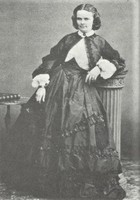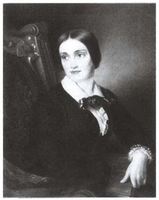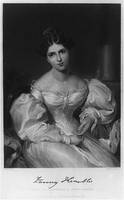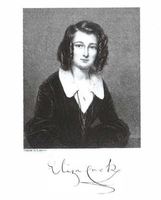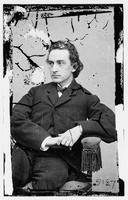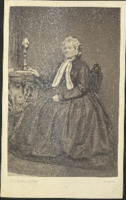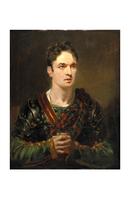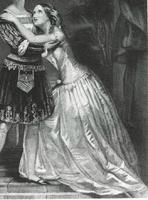Duyckinck's Portrait Gallery of Eminent Men and Women of Europe and America (1872-1874)
Dublin Core
Title
Duyckinck's Portrait Gallery of Eminent Men and Women of Europe and America (1872-1874)
Subject
Hosmer, Harriet Goodhue, 1830-1908
Cushman, Charlotte Saunders, 1816-1876
Cook, Eliza, 1818-1889
Gender Norms
Rumors
Reputation
Praise
Description
Mary Marble mentions the collection of short biographies to Lyman Beecher Stowe when he is working on a biography of Cushman.
Duyckinck's work comments on the lives of various artists and authors. The biographies include drawings/paintings of the respective artists. The biographical sketches are predominently favorable. They exclude comments on private affairs and include rumors (as in the case of Hosmer) only if doubts regarding their reputation could be dispelled entirely. Hosmer and Cushman are described as friends and Cook's relationship to Cushman is not mentioned at all.
The gender bending behavior of Hosmer is presented in a positive light as inspiring her genius as a sculptress.
Duyckinck's work comments on the lives of various artists and authors. The biographies include drawings/paintings of the respective artists. The biographical sketches are predominently favorable. They exclude comments on private affairs and include rumors (as in the case of Hosmer) only if doubts regarding their reputation could be dispelled entirely. Hosmer and Cushman are described as friends and Cook's relationship to Cushman is not mentioned at all.
The gender bending behavior of Hosmer is presented in a positive light as inspiring her genius as a sculptress.
Credit
Creator
Duyckinck, Evert A. (Evert Augustus), 1816-1878
Publisher
H. J. Johnson, Fry and Company
Date
1872-1874
Type
Reference
Auto/Biography Item Type Metadata
Text
Excerpts
Eliza Cook (458-460):
"[...] In 1849, she established a paper of her own, entitled " Eliza Cook's Journal," which was continued weekly till 1854, when it was given up in consequence of her failing health. A volume of selections from her papers in this periodical, entitled "Jottings from my Journal," was published by Routledge in 1860. This gathering of articles on topics of every-day life and manners is of a light, amusing, yet useful and practical character, and shows the authoress to be as clever in prose as in poetry. [...]"
Harriet Hosmer (615-623):
"[...] " I can see her now," said a lady to the writer who had known her in these years of her free, wild, independent life, " with her curly head, and her round, smiling face, and her little black dog under her arm, for she was fond of pets, and had a whole menagerie. [...]"Nevertheless," says Mrs. Child, the wellknown writer, who was a near neighbor for many years, " those who knew her well loved her dearly —there was never any immodesty in her fearlessness, nor any malice in her fun. Her childish tricks were those of a brave, roguish boy." [...] Hatty was accordingly enrolled as a student in a small private Academy conducted by the brother-in-law of Nathaniel Hawthorne. It is to be feared that books did not suit her active temperament, and that the discipline of school life became irksome to her untamed spirit, for it is on record that she was a most incorrigible pupil; and the first attempt at education was speedily brought to a close by the excellent preceptor himself, who informed her father that he could "do nothing with her." Another attempt was made, and still another ; each failure being followed by a respite from intellectual labor, during which the little girl was allowed to run wild again. [...] Thus the years passed, and at the age of fifteen our young artist was cousigned to the care of Mrs. Charles Sedgwick, of Lenox, Massachusetts. Here she remained for three years, acquiring a fund of useful knowledge and forming many pleasant friendships, which after years only served to strengthen. [...] In this resolve she arrived in Rome, in the commencement of 1853, and presented herself to Mr. John Gibson, then in the zenith of his fame [...] Her good friend, Mr. Wayman Crow, of St. Louis, desired to possess the first statue which she should execute in marble.[...] Zenobia [...] When this statue was first exhibited in London, it was whispered that Miss Hosmer was not its real author, that its execution was due to an Italian sculptor, and one journal went so far as to publish this report as correct. No time was lost, and an action for libel was immediately commenced against the journal by the indignant artist. Finding that Miss Hosmer was in earnest, the editor proposed an apology, which was accepted, upon the condition that Miss Hosmer's lawyer should dictate the apology, and that it should be submitted to her for approval. [...] Miss Hosmer is now (1874) engaged upon two works which are destined for our own country [...] her conversation is original and most inspiriting, and no one can long be oppressed with low spiiits when her voice is heard. Few women are so witty, though she herself declares that she never said but one witty thing. It was while driving one day with Miss Cushman, and crossing the Tiber, her friend remarked, "How angry the river looks." " Ah! " said Miss Hosmer, " some one has crossed it.' This, she maintains, is her one witty speech, but no one would venture to assert this but herself. [...] Previous to her last visit to Rome, the Empress of Austria, herself a renowned horsewoman, declared that there was nothing she looked forward to with more interest in Rome, than to see Miss Hosmer ride. Possessing an independent fortune, Miss Hosmer is free from the professional anxieties which assail too many artists. Her work, as we have already said, is not her necessity, but her choice; but there are few artists, whatever their circumstances, who labor so indefatigably. Riding is her only pastime, and that is as much for healthas pleasure. Gifted with rare talents, with the happiest temperament, and in the constant exercise of an art which to her is an ever new delight there are few human beings upon whom Fortune has so truly smiled as upon Harriet Hosmer."
Charlotte Cushman (554-557):
"[...] Robert Cushman, of whom she is a descendant, was one of the founders of Plymouth Colony, a member of the original band of Nonconformists, in Holland, who crossed the Atlantic in the " Mayflower." He came over in the succeeding vessel, in 1621, in time to preach the first sermon in America that was printed. [...] "This," says one of her biographers, " was a novel proposal, certainly ; but, however welcome to herself, our readers will conceive its horror to the hearts of her good family. Presbyterians, and descendants of a leader of the Puritans, they were perhaps the very last to give it an instant's consideration. Of all forms of earthly vanity, they had been taught to abhor the stage the most and to assent to her adopting it, was nothing loss than becoming parties to her surrender to perdition. It was now that that resolution for which she was remarkable, gave the first proof of its strength. More enlightened than her family, and consequently more tolerant, she had learned to value instruments by their grandest applications, and thus even to regard the stage as a means that might be elevated to the heicrht of a moral agent. [...] At the close of the season in New Orleans, Miss Cushman came to New York; and, being unable to obtain an engagement at the Park Theatre, made her appearance at the Bowery Theatre, under the management of Mr. Hamblin, in Lady Macbeth. Her performances here, the proceeds of which were devoted to the support of her family, were interrupted by illness; and before her health was restored, the theatre was destroyed by fire, and with it all her theatrical wardrobe was lost. She subsequently, in April, 1837, (to follow the record of Mr. Ireland, in his valuable work on the New York Stage), made her appearance at the old National Theatre, then under the management of Mr. Hackett, in Romeo, [...] Miss Cushman was subsequiently engaged at Philadelphia, where her merits attracted the attention of Mr. Macready, in his visit to the country in 1844. She appeared with him in leading parts during his engagement at the Park Theatre in New York; and her success being now fully established on the American boards, she shortly after left with her sister for England, to pursue her advantages on the London stage. She was engacred at the Princess's Theatre in that metropolis, making her first appearance there in February, 1845, in the character of Bianca in "Fazio."[...] In the followincr season, Miss Cushman played an engagement at Haymarket Theatre in which she appeared as Romeo to her sister Susan's Juliet. The latter was admired for its beauty and delicacy, and the former, whilst regarded as a bold venture and in some degree as an exceptional performance, was described as " one of the most extraordinary pieces of acting, perhaps, ever exhibited by a woman —masculine in deportment, artistic in conception, complete in execution, positive in its merits, both in parts and as a whole, and successful in its immediate impression." [...]"
Eliza Cook (458-460):
"[...] In 1849, she established a paper of her own, entitled " Eliza Cook's Journal," which was continued weekly till 1854, when it was given up in consequence of her failing health. A volume of selections from her papers in this periodical, entitled "Jottings from my Journal," was published by Routledge in 1860. This gathering of articles on topics of every-day life and manners is of a light, amusing, yet useful and practical character, and shows the authoress to be as clever in prose as in poetry. [...]"
Harriet Hosmer (615-623):
"[...] " I can see her now," said a lady to the writer who had known her in these years of her free, wild, independent life, " with her curly head, and her round, smiling face, and her little black dog under her arm, for she was fond of pets, and had a whole menagerie. [...]"Nevertheless," says Mrs. Child, the wellknown writer, who was a near neighbor for many years, " those who knew her well loved her dearly —there was never any immodesty in her fearlessness, nor any malice in her fun. Her childish tricks were those of a brave, roguish boy." [...] Hatty was accordingly enrolled as a student in a small private Academy conducted by the brother-in-law of Nathaniel Hawthorne. It is to be feared that books did not suit her active temperament, and that the discipline of school life became irksome to her untamed spirit, for it is on record that she was a most incorrigible pupil; and the first attempt at education was speedily brought to a close by the excellent preceptor himself, who informed her father that he could "do nothing with her." Another attempt was made, and still another ; each failure being followed by a respite from intellectual labor, during which the little girl was allowed to run wild again. [...] Thus the years passed, and at the age of fifteen our young artist was cousigned to the care of Mrs. Charles Sedgwick, of Lenox, Massachusetts. Here she remained for three years, acquiring a fund of useful knowledge and forming many pleasant friendships, which after years only served to strengthen. [...] In this resolve she arrived in Rome, in the commencement of 1853, and presented herself to Mr. John Gibson, then in the zenith of his fame [...] Her good friend, Mr. Wayman Crow, of St. Louis, desired to possess the first statue which she should execute in marble.[...] Zenobia [...] When this statue was first exhibited in London, it was whispered that Miss Hosmer was not its real author, that its execution was due to an Italian sculptor, and one journal went so far as to publish this report as correct. No time was lost, and an action for libel was immediately commenced against the journal by the indignant artist. Finding that Miss Hosmer was in earnest, the editor proposed an apology, which was accepted, upon the condition that Miss Hosmer's lawyer should dictate the apology, and that it should be submitted to her for approval. [...] Miss Hosmer is now (1874) engaged upon two works which are destined for our own country [...] her conversation is original and most inspiriting, and no one can long be oppressed with low spiiits when her voice is heard. Few women are so witty, though she herself declares that she never said but one witty thing. It was while driving one day with Miss Cushman, and crossing the Tiber, her friend remarked, "How angry the river looks." " Ah! " said Miss Hosmer, " some one has crossed it.' This, she maintains, is her one witty speech, but no one would venture to assert this but herself. [...] Previous to her last visit to Rome, the Empress of Austria, herself a renowned horsewoman, declared that there was nothing she looked forward to with more interest in Rome, than to see Miss Hosmer ride. Possessing an independent fortune, Miss Hosmer is free from the professional anxieties which assail too many artists. Her work, as we have already said, is not her necessity, but her choice; but there are few artists, whatever their circumstances, who labor so indefatigably. Riding is her only pastime, and that is as much for healthas pleasure. Gifted with rare talents, with the happiest temperament, and in the constant exercise of an art which to her is an ever new delight there are few human beings upon whom Fortune has so truly smiled as upon Harriet Hosmer."
Charlotte Cushman (554-557):
"[...] Robert Cushman, of whom she is a descendant, was one of the founders of Plymouth Colony, a member of the original band of Nonconformists, in Holland, who crossed the Atlantic in the " Mayflower." He came over in the succeeding vessel, in 1621, in time to preach the first sermon in America that was printed. [...] "This," says one of her biographers, " was a novel proposal, certainly ; but, however welcome to herself, our readers will conceive its horror to the hearts of her good family. Presbyterians, and descendants of a leader of the Puritans, they were perhaps the very last to give it an instant's consideration. Of all forms of earthly vanity, they had been taught to abhor the stage the most and to assent to her adopting it, was nothing loss than becoming parties to her surrender to perdition. It was now that that resolution for which she was remarkable, gave the first proof of its strength. More enlightened than her family, and consequently more tolerant, she had learned to value instruments by their grandest applications, and thus even to regard the stage as a means that might be elevated to the heicrht of a moral agent. [...] At the close of the season in New Orleans, Miss Cushman came to New York; and, being unable to obtain an engagement at the Park Theatre, made her appearance at the Bowery Theatre, under the management of Mr. Hamblin, in Lady Macbeth. Her performances here, the proceeds of which were devoted to the support of her family, were interrupted by illness; and before her health was restored, the theatre was destroyed by fire, and with it all her theatrical wardrobe was lost. She subsequently, in April, 1837, (to follow the record of Mr. Ireland, in his valuable work on the New York Stage), made her appearance at the old National Theatre, then under the management of Mr. Hackett, in Romeo, [...] Miss Cushman was subsequiently engaged at Philadelphia, where her merits attracted the attention of Mr. Macready, in his visit to the country in 1844. She appeared with him in leading parts during his engagement at the Park Theatre in New York; and her success being now fully established on the American boards, she shortly after left with her sister for England, to pursue her advantages on the London stage. She was engacred at the Princess's Theatre in that metropolis, making her first appearance there in February, 1845, in the character of Bianca in "Fazio."[...] In the followincr season, Miss Cushman played an engagement at Haymarket Theatre in which she appeared as Romeo to her sister Susan's Juliet. The latter was admired for its beauty and delicacy, and the former, whilst regarded as a bold venture and in some degree as an exceptional performance, was described as " one of the most extraordinary pieces of acting, perhaps, ever exhibited by a woman —masculine in deportment, artistic in conception, complete in execution, positive in its merits, both in parts and as a whole, and successful in its immediate impression." [...]"
Location
NYC, NY, US
Geocode (Latitude)
40.7127281
Geocode (Longitude)
-74.0060152
Provenance
Hathi, https://hdl.handle.net/2027/uc2.ark:/13960/t7br92k9m. Accessed 26 Feb, 2020.
Mentioned by
Mary Marble to Lyman Beecher Stowe, Feb 21, 1941, in: Beecher-Stowe family Papers, 1798-1956. Charlotte Saunders Cushman, 1816-1876. LBS. Corres, re Charlotte Cushman, 1941-1942, 1949 A-102, folder 433a. Schlesinger Library, Radcliffe Institute, Harvard University, Cambridge, Mass., seq. 17-19, http://nrs.harvard.edu/urn-3:RAD.SCHL:10355868?n=17. Accessed 26 February 2020
Mentioned by
Mary Marble to Lyman Beecher Stowe, Feb 21, 1941, in: Beecher-Stowe family Papers, 1798-1956. Charlotte Saunders Cushman, 1816-1876. LBS. Corres, re Charlotte Cushman, 1941-1942, 1949 A-102, folder 433a. Schlesinger Library, Radcliffe Institute, Harvard University, Cambridge, Mass., seq. 17-19, http://nrs.harvard.edu/urn-3:RAD.SCHL:10355868?n=17. Accessed 26 February 2020
Social Bookmarking
Geolocation
Collection
Citation
Duyckinck, Evert A. (Evert Augustus), 1816-1878, “Duyckinck's Portrait Gallery of Eminent Men and Women of Europe and America (1872-1874),” Archival Gossip Collection, accessed April 23, 2024, https://www.archivalgossip.com/collection/items/show/192.


